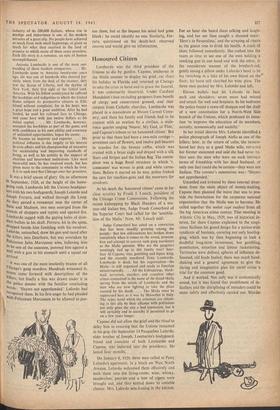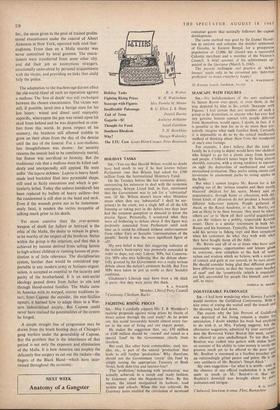Honoured Citizen
Lombardo was the third president of the Unione to die by gunfire. Capone, unshaven in the Mafia manner to display his grief, cut short his holiday in Florida and returned to Chicago to take the crisis in hand and to grace the funeral. It was customarily theatrical. Under Cardinal Mundelein's ban excluding gangsters from benefit of clergy and consecrated ground, and their corpses from Catholic churches, Lombardo was placed in a mausoleum at Mount Carmel Ceme- tery, and there his family and friends had to be content with an oration by a civilian, a male- voice quartet singing 'Nearer, My God, to Thee,' and Capone's tribute to 'an honoured citizen.' But prior to that there had been a two-mile cortege— seventeen cars of flowers, and twelve pall-bearers in tuxedos for the bronze coffin, which was crested with a brass eagle and, draped with a silk Stars and Stripes and the Italian flag. The centre- piece was a huge floral structure in which `T. LOMBARDO' was woven in pink and white carna- tions. Before it started on its way, police frisked the cars for machine-guns and the mourners for revolvers.
At his death the 'honoured citizen' came in for close scrutiny by Frank J. Loesch, president of the Chicago Crime Commission. Following the recent kidnapping by Black Handers of a ten- year-old Italian boy, Judge Frank Comerford of the Superior Court had called for the 'annihila- tion of the Mafia.' Now, Mr. Loesch said:
Judge Comerford has acted on a conviction that has been steadily growing among the people: that law enforcement has broken down completely when it comes to the arrest, prosecu- tion and attempt to convict such gang murderers as the Mafia gunmen. Who are the gangsters seemingly tied up to this family tree? Scar- face Al Capone, vice, gambling and liquor king, and the recently murdered Tony Lombardo. Lombardo is dead, but his organisation—the Mafia—is still organised and ready to function uninterruptedly. . . All the kidnappings, black- mail, terrorism, murders and countless other crimes committed in the name of the dread Mafia sprang from the minds of Lombardo and the men who are now fighting to take the place vacated by his death. . . . The Mafia must be suppressed here as it was by Mussolini in Italy. The upper hand which the criminals are obtain- ing in this city by their alliance with politicians not only gives the city a bad reputation, but it will certainly end in anarchy if permitted to go on a few years longer.
Capone did not allow the grief and the ritual to delay him in ensuring that the Unione remained in his grip, On September 14 Pasqualino Lolordo, elder brother of Joseph, Lombardo's bodyguard, friend and associate of both Lombardo and Capone, was inducted into the presidency. He lasted four months.
On January 8, 1929, three men called at Patsy Lolordo's apartment, in a block on West North Avenue. Lolordo welcomed them effusively and took• them into the living-room; wine, whisky, sandwiches, pastries and a box of cigars were brought out, and they settled down to amiable chatter. Mrs. Lolordo was ironing in the kitchen. For an hour she heard them talking and laugh- ing, and her ear then caught a shouted toast : `Here's to Pasqualino,' and the scraping of chairs as the guests rose to drink his health. A crash of shots followed immediately. She rushed into the room in time to see one of the men holding a smoking gun in one hand and with the other, in the considerate manner of the brotherhood, gently easing a pillow under. Lolordo's head as he lay twitching in a lake of his own blood on the'' floor; his hand still clutched his wine glass. the three men pushed by Mrs. Lolordo and left.
Eleven bullets had hit Lolordo in face, neck and shoulders; seven more had missed and struck the wall and fireplace. In his bedroom the police found a sawn-off shotgun and the draft of a new constitution for a North-West Side branch of the Unione, which professed its inten- tion `to improve the education of its members, morally, economically and socially.'
In her initial distress Mrs. Lolordo identified a police photograph of Joseph Aiello as one of the killers; later, in the return of calm, she remem- bered her duty as a good Mafia wife, retracted her former statement and said she had never be- fore seen the men who were on such intimate terms of friendship with her dead husband, of only one fact could she be certain—they were not Italians. The coroner's summation was : 'Slayers not apprehended.'
Unsettled and irritated by these internal diver- sions from the main object of money-making, Capone then planned the move that was to pro- vide the foundations for the corporate national organisation that the Mafia was to become. He called together the senior capi mafiosi from all the big American crime centres. That meeting in Atlantic City in May, 1929, was of historical in- terest, for there Capone explained to the suspi- cious Sicilians his grand design for a nation-wide syndicate of business, covering not only bootleg- ging, which was by then beginning to look a doubtful long-term investment, but gambling, prostitution, extortion and labour racketeering. Territories were defined, spheres of influence de- lineated, old feuds healed; there was much hand- shaking and a general agreement to give the daring and imaginative plan for cartel crime a trial for the common good.
And it worked. Not only was it economically sound, but it was found that punishment of de- faulters and the disciplining of intruders'could be more safely and effectively carried out. Murder Inc., the name given to the pool of trained profes- sional executioners under the control of Albert Anastasia in New York, operated with cool thor- oughness. From then on a Mafia murder was never committed by local gunmen. The execu- tioners were transferred from some other city, and did their job as anonymous strangers, emotionally uninvolved by personal acquaintance with the victim, and providing no links that could help the police.
The adaptation to the machine age did not affect the old-world ritual of such an operation against a mafioso. The 'kiss of death' was still exchanged between the chosen executioners. The victim was still, if possible, lured into a benign state for his last hours : wined and dined until enjoyably soporific, whereupon the gun was raised upon his skull from behind and he was dispatched in com- fort from this world. In pious respect of his memory, the brethren still allowed stubble to grow on their chins from the day of the demise until the day of the funeral. For a nod-mafioso, less thoughtfulness was shown : for security reasons the assault had to be conclusively mortal, but finesse was sacrificed to ferocity. But the traditiorial rule that a mafioso must be killed sud- denly and unexpectedly still applied. He must suffer 'the lupera sickness.' Lupera is heavy hand- made lead buckshot filed into pyramidal shape, still used in Sicily executions and which is par- ticularly lethal. Today this tedious handicraft has been replaced by bullets of heavy calibre—but the condemned is still shot in the head and neck. Even if the wounds prove not to be instantane- ously fatal, it renders the victim incapable of talking much prior to his death.
Yet more coercive than the ever-present weapon of death for .failure or betrayal is the ethic of the Mafia, the desire to remain in grace, to be worthy of the respect of the brethren. Status within the group is the criterion, and that this is achieved by income derived from selling heroid to high-school children or running houses of pros- titution is of little relevance. The disciplinarian system, harsher than would be considered sup- portable in any modern army or.business organi- sation, is accepted as essential to the an and purity of the brotherhood. It is an anti-social ideology passed down from father to son and through blood-united families. The Mafia came to America with its warped, sinister traditions in- tact; from Capone the outsider, the non-Sicilian upstart, it learned how to adapt them to a Wes- tern industrialised society. But Capone could never have realised the potentialities of the system he forged.
A simple straight line of progression may be drawn from the brash bootleg days of Chicago's gang warfare under the generalship of Capone. But the problem that is the inheritance of that period is not only the exposure and elimination of the Mafia. It is how America can employ the delicately fine surgery to cut out the rackets—the fingers of the Black Hand—which have inter- twined throughout the economy.































 Previous page
Previous page